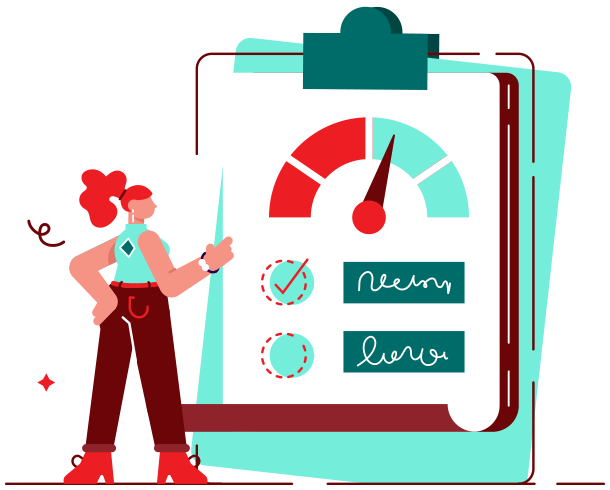


So you have a great idea. Now what?
You’ve done your homework. You know what goals you want to achieve and what problems you need to solve. You have the research to back it up. You’ve looked at all of the information individually and as a team. You’ve stayed awake nights thinking about it. Finally, after multiple brainstorming sessions, your team has come up with a BIG IDEA. (Hint: A BIG IDEA usually takes the form of “Ok, so here’s what we need to do.”) Congratulations – you have the “What” figured out! Now it’s time to think about the “How.” That’s where organization (and your friendly neighborhood account manager) comes in.
Time to make a plan.
Without a road map (or GPS), you probably aren’t arriving at that previously-unknown destination. And without a plan, you won’t achieve your brand-new-and-exciting marketing goals. Read that sentence again. Marketing is complex. There are so many people, ideas, and steps involved. Your BIG IDEA is not going to just magically come to fruition. You need a plan.


Put your big ideas into action by figuring out the HOW.
How To Execute Your ‘How’: A Guide
If you’ve never really tried to officially organize the execution of a BIG IDEA before, it may seem a little daunting at first. Here are a few tips to consider to help you get you started.
Work backwards.

Know who is responsible for each and every step.
Just like every step has a deadline, every single part of the process has to be owned by someone on the team. Without ownership, tasks will not be completed on time. Make sure everyone understands who is responsible for what. Then think of it like a relay race, and don’t drop the baton!
Communicate!
This is so important. As you complete each task on your list, TELL SOMEONE YOU DID IT. In other words, pass the baton. Basically, you should in some shape/form/fashion say to your teammate “I did X. Looking at the plan, I see that Y is next, and that you are taking charge of that, so I wanted to let you know that you can move forward when you are ready!” There are multiple ways to communicate this, and it all depends on your team dynamic and the generally accepted and agreed-upon forms of communication.


If possible, use some kind of project management software.
It really, truly helps. Trust me. Project management software saves time and energy, which ultimately means money. We love Asana (not just because it has cute features like magical creatures who fly across the screen when you check off a task), but there are other software systems available as well.
Project management software helps to streamline your process by putting all of the information in one place where everyone on the team can find it at any point. Need to know the status of your project? Just read the last comment posted, or take a look at who checked off the last task. It’s as simple as that, and so worthwhile.

Schedule times to check in.
Even with all of the digital communication in the world, occasional face-to-face communication can prove invaluable in keeping everyone on the same page and moving your project forward. As part of your overall process, make sure to schedule regular check-in meetings, and get them on the calendar. If possible, have your elected organized person create an agenda for each one as it approaches, so you don’t waste anyone’s time.


Take detailed notes.
All along the way, important pieces of information will come to your collective attention. Make sure someone writes them down! As mentioned above, the red thread team loves Asana, and that’s where we put all of our important information, from research we want to share, to information received in a client meeting, to questions we encounter as we work.

Be ready to be flexible.
Even though you made a detailed plan, it’s important to constantly evaluate before, during, and after the execution of that project. Be open to improving or even completely changing your process along the way. You don’t want to get stuck in a rut before you’ve even begun! Always ask yourself “Is there a better way to do this?” If the answer is yes, go back up a few tips…and communicate! Tell your project manager you may have landed on a better solution to the problem at hand. Project managers: Stay open to new ideas from your team! Since most projects are a group effort, you may not see an issue with an individual task when you are looking at the big picture. But the person assigned to complete that task will. If someone on your team comes to you with a problem, try to help them solve it. Likewise, if they come to you with a solution, consider incorporating it into the process. Remember that there’s always more than one way to achieve any goal. Be in the business of constantly seeking the smartest and most efficient way.
Evaluate.
Hooray, you completed your project! Now it’s time to evaluate your results. Did you finish on time? What problems did you encounter along the way? What were the solutions? Are there solutions that might work better next time? What happened that you didn’t expect? What was your return on investment? What successes do you have to celebrate? What could be done better next time? All of these are important questions to consider as your team becomes a well-organized marketing machine.

Final Thoughts
If you remember nothing else from reading this blog, remember this: Without a “How” you will not successfully achieve your “What.” You may firmly believe in WHY you are doing something, and know exactly WHAT you want to do, but without that final piece – HOW you are going to achieve it – you’ll probably end up right back where you started… with a lot of great ideas that never saw the light of day. So start investing in your organizational process now, and you’ll be on your way to actually reaching those BIG IDEA goals! And that’s igniting passion with action.
Ready to put your BIG IDEA into action?